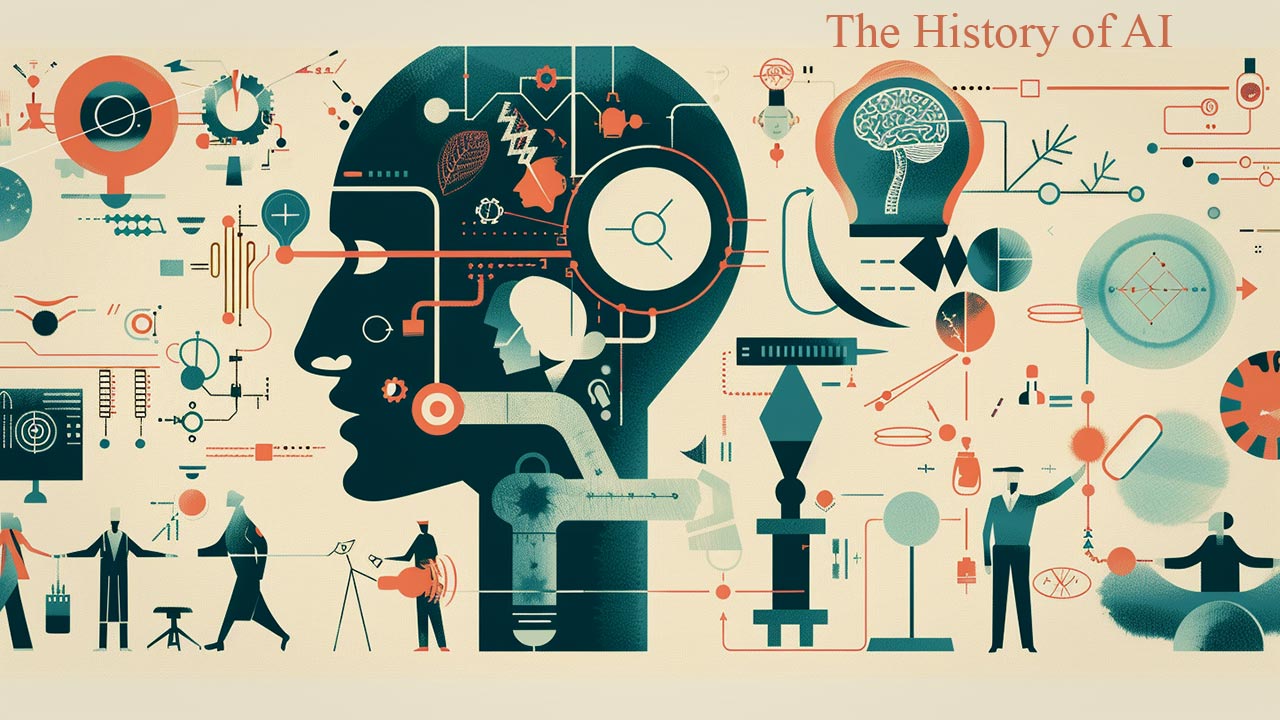The History of AI
The History of AI journey, spanning over seven decades, has been marked by groundbreaking research, periods of optimism and disillusionment, and the eventual emergence of AI as a cornerstone of modern technology. In this article, you’ll embark on a comprehensive exploration of AI’s historical trajectory, from its early theoretical foundations to the sophisticated applications driving today’s innovation.
You’ll learn about the key milestones in AI’s development, the visionary thinkers who laid the groundwork, and the technological advancements that turned speculative ideas into reality. We’ll delve into the various “AI winters” that slowed progress and examine how the field eventually rebounded with renewed vigor.
Table of Contents
- The Birth of AI: Early Theoretical Foundations
- The Rise of Symbolic AI: The 1950s and 1960s
- AI Winters: Periods of Disillusionment
- The Emergence of Machine Learning: 1990s to Early 2000s
- The AI Renaissance: 2010s to Present
- Ethical and Societal Implications of AI
- Top 5 Frequently Asked Questions
- Final Thoughts
- Research
The Birth of AI: Early Theoretical Foundations
The Turing Test and Early Concepts
The conceptual roots of AI can be traced back to the mid-20th century when British mathematician Alan Turing proposed what is now famously known as the Turing Test. Turing’s groundbreaking paper, “Computing Machinery and Intelligence,” published in 1950, questioned whether machines could exhibit intelligent behavior indistinguishable from that of a human. This thought experiment set the stage for what would eventually become the field of Artificial Intelligence.
Turing’s ideas were influenced by earlier theoretical work in mathematics and logic, particularly the notion of a “universal machine” that could perform any calculation given the right algorithms. These early concepts laid the groundwork for thinking about machines not just as calculators but as entities capable of reasoning and learning.
Cybernetics and the Dawn of Computational Models
In parallel to Turing’s work, the 1940s and 1950s saw the rise of cybernetics, a field focused on the study of communication and control in animals and machines. Pioneers like Norbert Wiener and Warren McCulloch explored the idea of feedback loops and neural networks, which are now fundamental concepts in AI. Their work provided early models of how machines could mimic human cognitive processes, leading to the development of the first rudimentary AI systems.
The Rise of Symbolic AI: The 1950s and 1960s
The Dartmouth Conference: AI’s Official Birth
In 1956, the Dartmouth Conference, organized by John McCarthy, Marvin Minsky, Nathaniel Rochester, and Claude Shannon, officially coined the term “Artificial Intelligence.” This event is often regarded as the birth of AI as a distinct field of study. The conference brought together leading researchers who shared a common goal: to create machines capable of performing tasks that would require intelligence if done by humans.
Early AI Programs and Achievements
The post-Dartmouth era witnessed the development of the first AI programs. One notable example is the Logic Theorist, developed by Allen Newell and Herbert A. Simon, which was capable of proving mathematical theorems. This period also saw the creation of General Problem Solver (GPS) and the development of LISP, the first AI programming language, by John McCarthy. These early programs were rule-based systems, where the AI would follow pre-defined steps to solve problems—a paradigm known as symbolic AI or “Good Old-Fashioned AI” (GOFAI).
AI Winters: Periods of Disillusionment
The First AI Winter (1974-1980)
Despite the early successes, the 1970s marked the beginning of a period of stagnation in AI research, known as the First AI Winter. The initial optimism was tempered by the realization that many AI challenges, such as natural language processing and general problem-solving, were far more complex than anticipated. The lack of tangible progress led to reduced funding and interest, causing a slowdown in AI research and development.
The Second AI Winter (1987-1993)
The Second AI Winter in the late 1980s and early 1990s was triggered by similar factors: unmet expectations and the limitations of existing AI technologies. Expert systems, which had been the focus of much AI research, failed to deliver on their promise, leading to further disillusionment. Once again, funding dried up, and many researchers moved away from AI, resulting in another significant pause in progress.
The Emergence of Machine Learning: 1990s to Early 2000s
Neural Networks and Statistical Approaches
The 1990s marked a turning point in AI with the resurgence of interest in neural networks. Unlike symbolic AI, which relied on explicit programming, neural networks attempted to mimic the human brain’s structure, allowing machines to learn from data. This shift towards data-driven approaches, known as machine learning, enabled significant advancements in AI capabilities, particularly in areas like pattern recognition and language processing.
The Impact of Big Data and Improved Computing Power
The early 2000s brought about a confluence of factors that accelerated AI’s growth: the explosion of big data, the advent of cloud computing, and advancements in hardware, particularly Graphics Processing Units (GPUs). These developments provided the necessary resources for training large neural networks, leading to breakthroughs in AI performance across various domains.
The AI Renaissance: 2010s to Present
Deep Learning and the Breakthroughs in AI
The 2010s ushered in what many refer to as the AI Renaissance, driven primarily by the advent of deep learning—a subset of machine learning that involves training large neural networks with multiple layers. This approach led to significant improvements in areas such as computer vision, natural language processing, and speech recognition. Landmark achievements like Google’s AlphaGo defeating a world champion in Go and OpenAI’s GPT series revolutionized AI’s perceived capabilities.
AI in the Modern Era: Applications Across Industries
Today, AI is no longer a niche field confined to academia and research labs. It has permeated virtually every industry, from healthcare to finance to entertainment. AI-driven technologies are now integral to daily life, powering everything from virtual assistants to autonomous vehicles. The combination of deep learning, big data, and enhanced computing power continues to push the boundaries of what AI can achieve.
Ethical and Societal Implications of AI
Bias, Fairness, and Accountability
As AI becomes more pervasive, concerns about its ethical implications have grown. Issues such as algorithmic bias, lack of transparency, and the potential for AI to exacerbate inequalities have become central to discussions about AI’s future. Ensuring fairness, accountability, and transparency in AI systems is now a critical focus for researchers and policymakers.
The Future of AI: Opportunities and Challenges
Looking ahead, the future of AI holds both incredible opportunities and significant challenges. Advances in AI have the potential to drive innovation, improve efficiency, and solve complex global problems. However, these benefits must be balanced against the risks, including job displacement, privacy concerns, and the potential misuse of AI technologies. The ongoing development of AI will require careful consideration of these issues to ensure that the technology is used for the greater good.
Top 5 Frequently Asked Questions
Final Thoughts
The history of AI is a testament to the relentless pursuit of knowledge and the power of human ingenuity. From its early theoretical foundations to the modern era of deep learning and ubiquitous AI applications, the field has experienced remarkable growth and transformation. However, the most important takeaway is the recognition that AI’s future will be shaped not just by technological advancements but also by the ethical frameworks and societal values we choose to uphold. As AI continues to evolve, it is imperative that we guide its development with a focus on fairness, accountability, and the greater good, ensuring that the benefits of AI are shared equitably across all segments of society.
Research
- Turing, Alan. “Computing Machinery and Intelligence.” Mind, vol. 59, no. 236, 1950, pp. 433-460.
- McCarthy, John, et al. “A Proposal for the Dartmouth Summer Research Project on Artificial Intelligence.” 1956.
- Wiener, Norbert. Cybernetics: Or Control and Communication in the Animal and the Machine. MIT Press, 1948.
- Newell, Allen, and Herbert A. Simon. “The Logic Theory Machine: A Complex Information Processing System.” IRE Transactions on Information Theory, 1956.
- Russell, Stuart J., and Peter Norvig. Artificial Intelligence: A Modern Approach. 3rd ed., Pearson, 2010.
- Minsky, Marvin. The Society of Mind. Simon and Schuster, 1986.
- LeCun, Yann, Yoshua Bengio, and Geoffrey Hinton. “Deep Learning.” Nature, vol. 521, no. 7553, 2015, pp. 436-444.
- Bostrom, Nick. Superintelligence: Paths, Dangers, Strategies. Oxford University Press, 2014.









Leave A Comment